Experimental Evaluation of the Properties of Recycled Aggregate Pavement Brick with a Composite Shaped Phase Change Material
Abstract
:1. Introduction
2. Materials and Methods
2.1. Raw Materials and Proportion
2.2. Preparation of composite shaped PCM
2.2.1. Preparation Principle
2.2.2. Preparation Process
2.3. Preparation of Composite Shaped PCM Recycled Aggregate Pavement Bricks
2.4. Experimental Methods
2.5. Temperature Control Range Calculation
3. Results and Discussion
3.1. Microstructure
3.2. Thermal Reliability
3.3. Thermal Stability
3.4. Properties of the Recycled Aggregate Pavement Brick with Composite Shaped PCM
3.4.1. Mechanical Properties
3.4.2. Thermal Conductivity
3.4.3. Analysis of the Temperature Control Effect
4. Conclusions
Author Contributions
Funding
Institutional Review Board Statement
Informed Consent Statement
Data Availability Statement
Conflicts of Interest
References
- Liang, L.; Wang, Z.; Li, J. The effect of urbanization on environmental pollution in rapidly developing urban agglomerations. J. Clean. Prod. 2019, 237, 117649. [Google Scholar] [CrossRef]
- He, Z.; Shen, A.; Wu, H.; Wang, W.; Wu, J. Research progress on recycled clay brick waste as an alternative to cement for sustainable construction materials. Constr. Build. Mater. 2021, 274, 122113. [Google Scholar] [CrossRef]
- Wong, C.; Mo, K.; Yap, S.; Alengaram, U.J.; Ling, T. Potential use of brick waste as alternate concrete-making materials: A review. J. Clean. Prod. 2018, 195, 226–239. [Google Scholar] [CrossRef]
- Qin, T.; Ma, Z.; Wu, H.; Wang, W. The utilization of eco-friendly recycled powder from concrete and brick waste in new concrete: A critical review. Cem. Concr. Compos. 2020, 114, 103807. [Google Scholar]
- MA, Z.; Liu, M.; Duan, Z.; Liang, C.; Wu, H. Effects of active waste powder obtained from C&D waste on the microproperties and water permeability of concrete. J. Clean. Prod. 2020, 257, 120518. [Google Scholar]
- Xiao, J.; Ma, Z.; Sui, T.; Akbarnezhad, A.; Duan, Z. Mechanical properties of concrete mixed with recycled powder produced from construction and demolition waste. J. Clean. Prod. 2018, 188, 720–731. [Google Scholar] [CrossRef]
- Jiang, Y.; Ling, T.-C.; Shi, M. Strength enhancement of artificial aggregate prepared with waste concrete powder and its impact on concrete properties—ScienceDirect. J. Clean. Prod. 2020, 257, 120515. [Google Scholar] [CrossRef]
- Yang, Z.; Wu, Y.; Zhang, Z.; Li, H.; Li, X.; Egorov, R.I.; Strizhak, P.A.; Gao, X. Recent advances in co-thermochemical conversions of biomass with fossil fuels focusing on the synergistic effects. Renew. Sustain. Energy Rev. 2019, 103, 384–398. [Google Scholar] [CrossRef]
- Akhtar, A.; Sarmah, A.K. Construction and demolition waste generation and properties of recycled aggregate concrete: A global perspective. J. Clean. Prod. 2018, 186, 262–281. [Google Scholar] [CrossRef]
- Safari, A.; Saidur, R.; Sulaiman, F.A.; Xu, Y.; Dong, J. A review on supercooling of Phase Change Materials in thermal energy storage systems. Renew. Sustain. Energy Rev. 2017, 70, 905–919. [Google Scholar] [CrossRef]
- Karaipekli, A.; Biçer, A.; Sari, A.; Tyagi, V.V. Thermal characteristics of expanded perlite/paraffin composite phase change material with enhanced thermal conductivity using carbon nanotubes. Energy Convers. Manag. 2017, 134, 373–381. [Google Scholar] [CrossRef]
- Zhao, S.; Li, J.; Song, S. Preparation of porous titanium dioxide foam impregnated with polyethylene glycol as shape-stable composite phase change materials. Appl. Therm. Eng. 2022, 51, 104416. [Google Scholar] [CrossRef]
- Qudama, A.-Y.; Marta, S. Phase change material coupled building envelope for thermal comfort and energy-saving: Effect of natural night ventilation under hot climate. Renew. Sustain. Energy Rev. 2022, 365, 132839. [Google Scholar]
- Cheng, C.; Gong, F.; Fu, Y.; Liu, J.; Qiao, J. Effect of polyethylene glycol/polyacrylamide graft copolymerizaton phase change materials on the performance of asphalt mixture for road engineering. J. Mater. Res. Technol. 2021, 15, 1970–1983. [Google Scholar] [CrossRef]
- Muzhanje, A.T.; Hassan, M.A.; Hassan, H. Phase change material based thermal energy storage applications for air conditioning: Review. Appl. Energy 2022, 214, 118832. [Google Scholar] [CrossRef]
- Shoeibi, S.; Kargarsharifabad, H.; Mirjalily, S.A.A.M.; Meisam, S.; Ahmad, A. A comprehensive review of nano-enhanced phase change materials on solar energy applications. Energy Storage 2022, 50, 104262. [Google Scholar] [CrossRef]
- Zhao, Y.; Zhang, X.; Hua, W. Review of preparation technologies of organic composite phase change materials in energy storage. J. Mol. Liq. 2021, 336, 115923. [Google Scholar] [CrossRef]
- Tao, J.; Luan, J.; Liu, Y.; Qu, D.; Yan, Z.; Ke, X. Technology development and application prospects of organic-based phase change materials: An overview. Renew. Sustain. Energy Rev. 2022, 159, 112175. [Google Scholar] [CrossRef]
- Sharma, K.R.; Sandaran, C.S.; Ganesan, P.; Metselaar, S.H.; Tyagi, V.V. Developments in organic solid-liquid phase change materials and their applications in thermal energy storage. Energy Convers. Manag. 2015, 95, 193–228. [Google Scholar] [CrossRef]
- Sun, X.; Liang, X.; Yu, H.; Wang, Y.; Zhu, Z. Comparison the Performance of N-heptane, N-dodecane, N-tetradecane and N-hexadecane. Energy Procedia 2017, 105, 1426–1433. [Google Scholar] [CrossRef]
- Zhang, X.; Wang, X.; Wang, J.; Xu, X.; Hua, W.; Fang, M. Molecular dynamics simulation of phase transformation process of N-tetradecane. Energy Storage Sci. Technol. 2019, 8, 874–879. [Google Scholar]
- Feng, L.; Zhao, W.; Zheng, J.; Frisco, S.; Song, P.; Li, X. The shape-stabilized phase change materials composed of polyethylene glycol and various mesoporous matrices (AC, SBA-15 and MCM-41). Sol. Energy Mater. Sol. Cells 2011, 95, 3550–3556. [Google Scholar] [CrossRef]
- Qian, T.; Li, J.; Feng, W.; Nian, H. Single-walled carbon nanotube for shape stabilization and enhanced phase change heat transfer of polyethylene glycol phase change material. Energy Convers. Manag. 2017, 143, 96–108. [Google Scholar] [CrossRef]
- Wang, C.L.; Yeh, K.L.; Chen, C.W.; Lee, Y.; Lee, H.L.; Lee, T. A quick-fix design of phase change material by particle blending and spherical agglomeration. Appl. Energy 2017, 191, 239–250. [Google Scholar] [CrossRef]
- Chen, J.; Zhang, W.; Shi, X.; Yao, C.; Kuai, C. Use of PEG/SiO2 phase change composite to control porous asphalt concrete temperature. Constr. Build. Mater. 2020, 245, 118459. [Google Scholar] [CrossRef]
- Xu, T.; Chen, Q.; Zhang, Z.; Gao, X.; Huang, G. Investigation on the properties of a new type of concrete blocks in-corporated with PEG/SiO2 composite phase change material. Build. Environ. 2016, 104, 172–177. [Google Scholar] [CrossRef]
- Yan, D.; Ming, W.; Liu, S.; Yin, G.; Zhang, Y.; Tang, B.; Zhang, S. Polyethylene glycol (PEG)/silicon dioxide grafted aminopropyl group and carboxylic multi-walled carbon nanotubes (SAM) composite as phase change material for light-to-heat energy conversion and storage—ScienceDirect. J. Energy Storage 2021, 36, 102428. [Google Scholar] [CrossRef]
- Karaman, S.; Karaipekli, A.; Sar, A.; Biçer, A. Polyethylene Glycol (PEG)/Diatomite Composite as A Novel Form-Stable Phase Change Material for Thermal Energy Storage. Sol. Energy Mater. Sol. Cells 2011, 95, 1647–1653. [Google Scholar] [CrossRef]
- Fang, Y.; Yu, H.; Wan, W.; Gao, X.; Zhang, Z. Preparation and thermal performance of polystyrene/n-tetradecane composite nanoencapsulated cold energy storage phase change materials. Energy Convers. Manag. 2013, 76, 430–436. [Google Scholar] [CrossRef]
- Bai, J.; Li, S.; Liu, X.; Xiao, L. Preparation and properties of low temperature phase change microcapsules for road use. Sci. Technol. Eng. 2021, 21, 7752–7761. [Google Scholar] [CrossRef]
- Fang, G.; Li, H.; Yang, F.; Liu, X.; Wu, S. Preparation and characterization of nano-encapsulated n-tetradecane as phase change material for thermal energy storage. Chem. Eng. J. 2009, 153, 217–221. [Google Scholar] [CrossRef]
- Lv, Y.; Zhou, W.; Jin, W. Experimental and numerical study on thermal energy storage of polyethylene gly-col/expanded graphite composite phase change material. Energy Build. 2016, 111, 242–252. [Google Scholar] [CrossRef]
- Ren, H.; Jing, Y.; Song, J.; Liu, Y.; Chen, L. Experimental Analysis Technologies of Scanning Electron Microscopy and Its Application. Petrochem. Ind. Technol. 2018, 25, 115. [Google Scholar]
- Quan, X.; Du, Y.; Ma, C.; Guo, W.; Liu, P.; Tian, J.; Wu, X.; Deng, X. Improving latent heat storage capacity of poly-ethylene glycol/cement composite prepared via solution blending method. Sol. Energy 2021, 230, 355–364. [Google Scholar] [CrossRef]
- Mokhtari, S.; Morteza, M. The performance effect of PEG-silica fume as shape-stabilized phase change materials on mechanical and thermal properties of lightweight concrete panels. Case Stud. Constr. Mater. 2022, 17, e01298. [Google Scholar] [CrossRef]
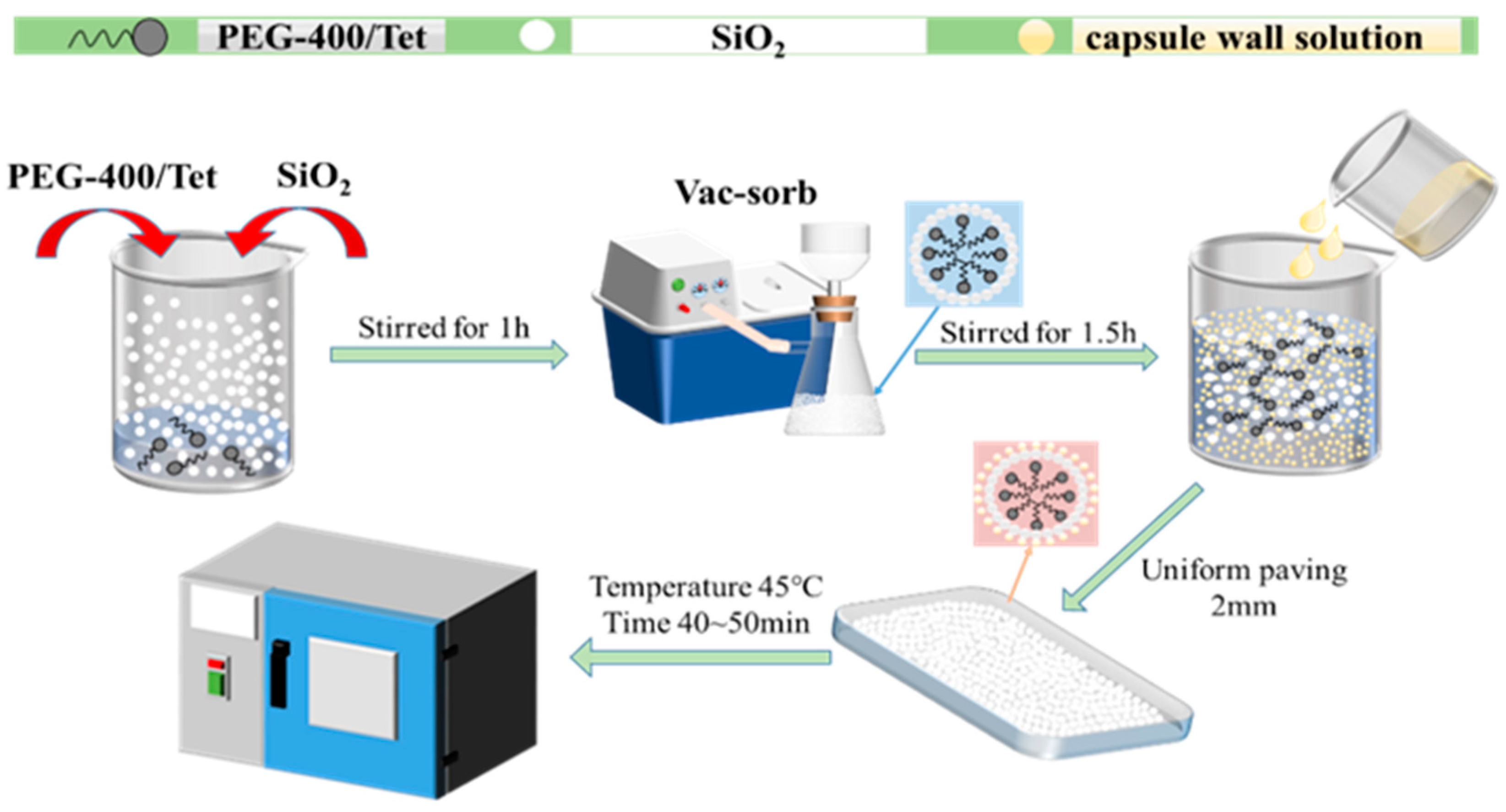

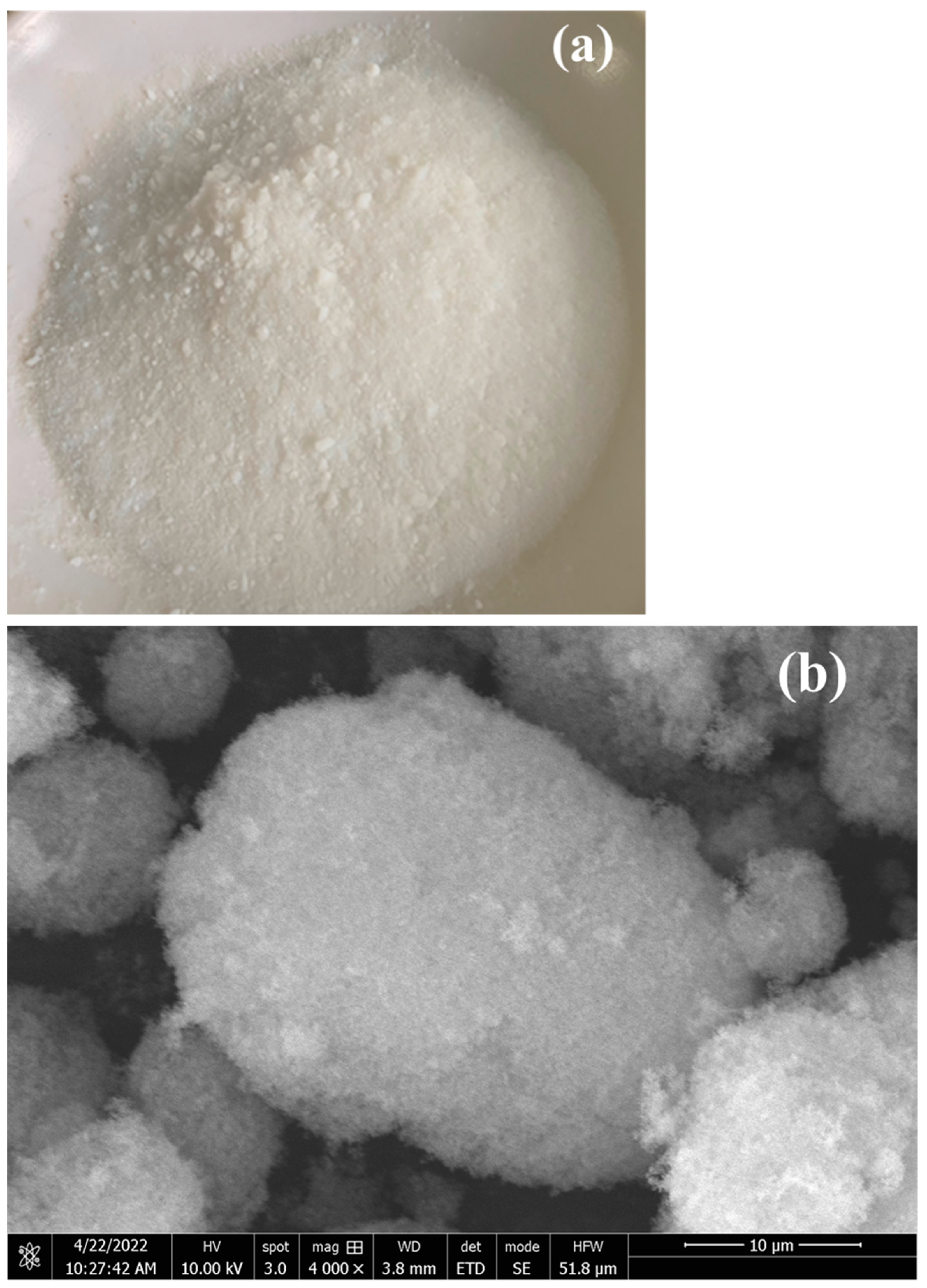

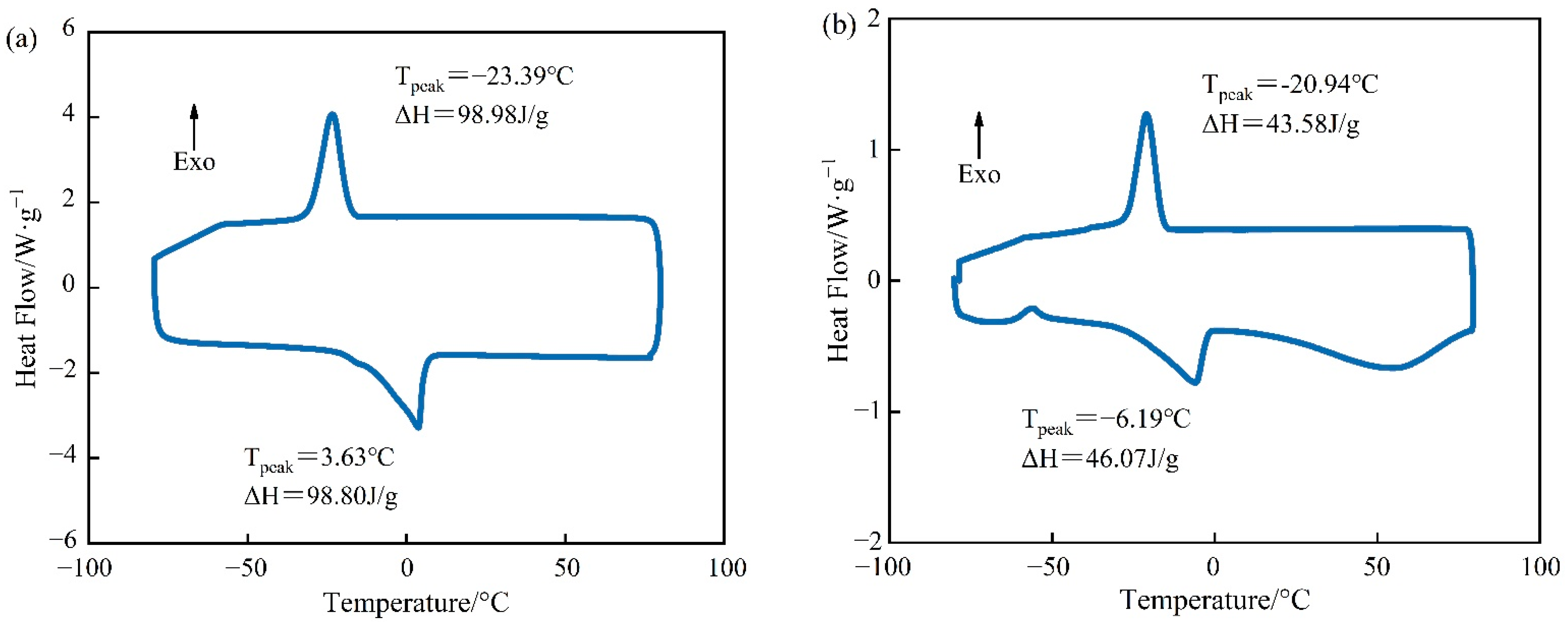

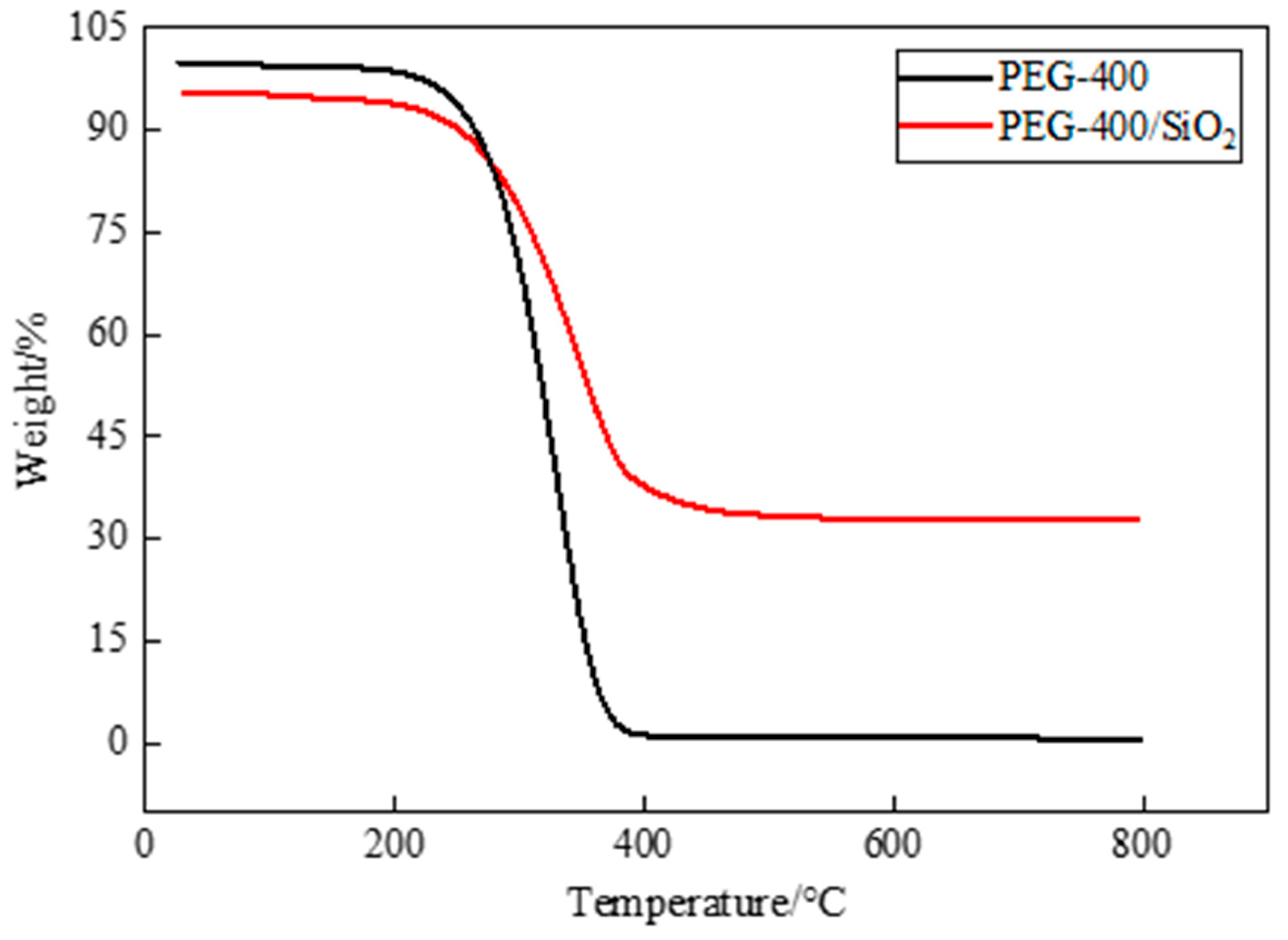
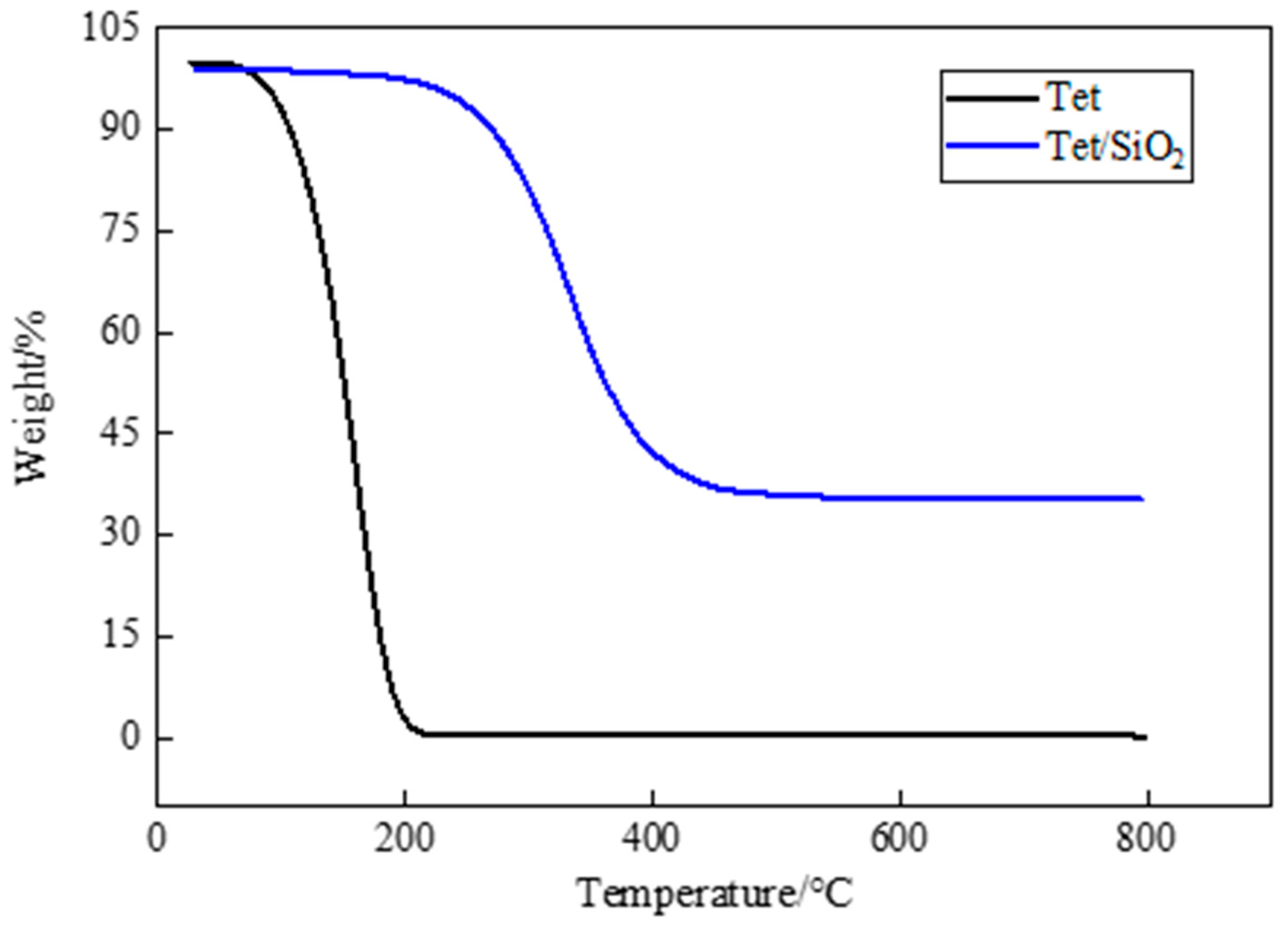
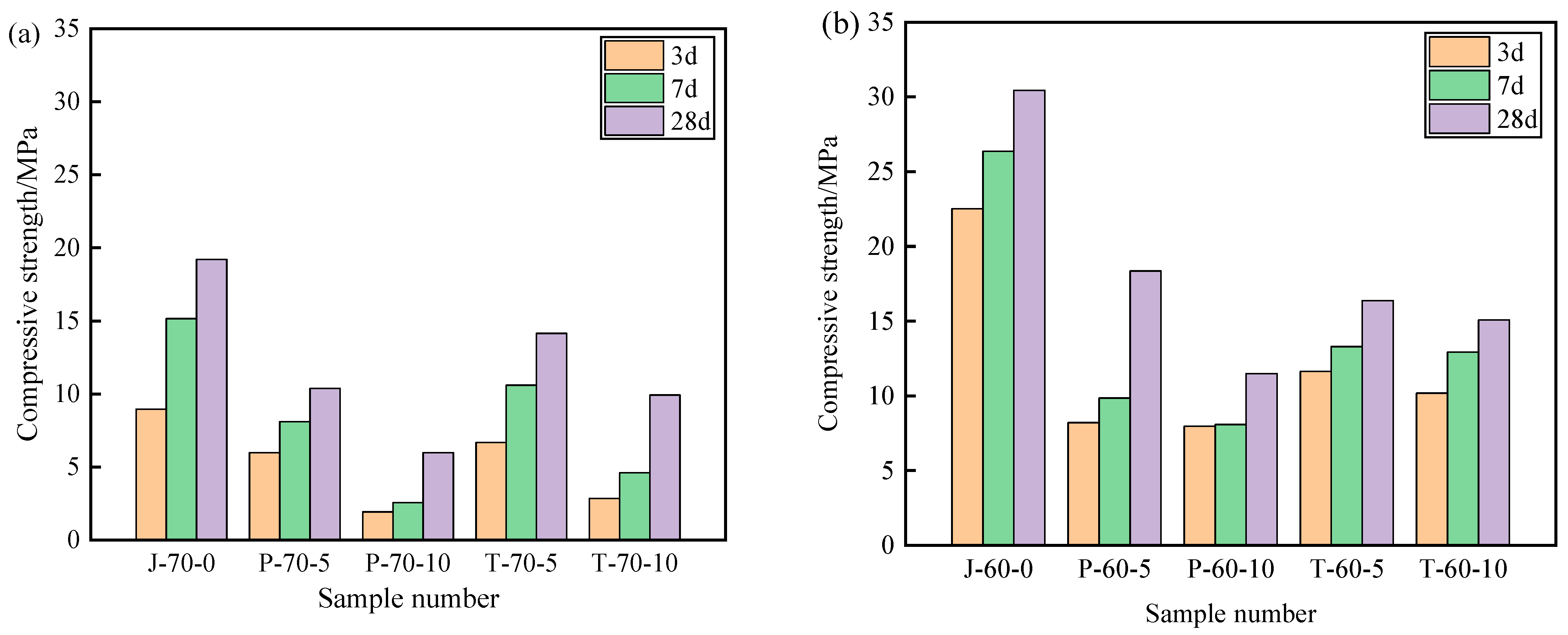
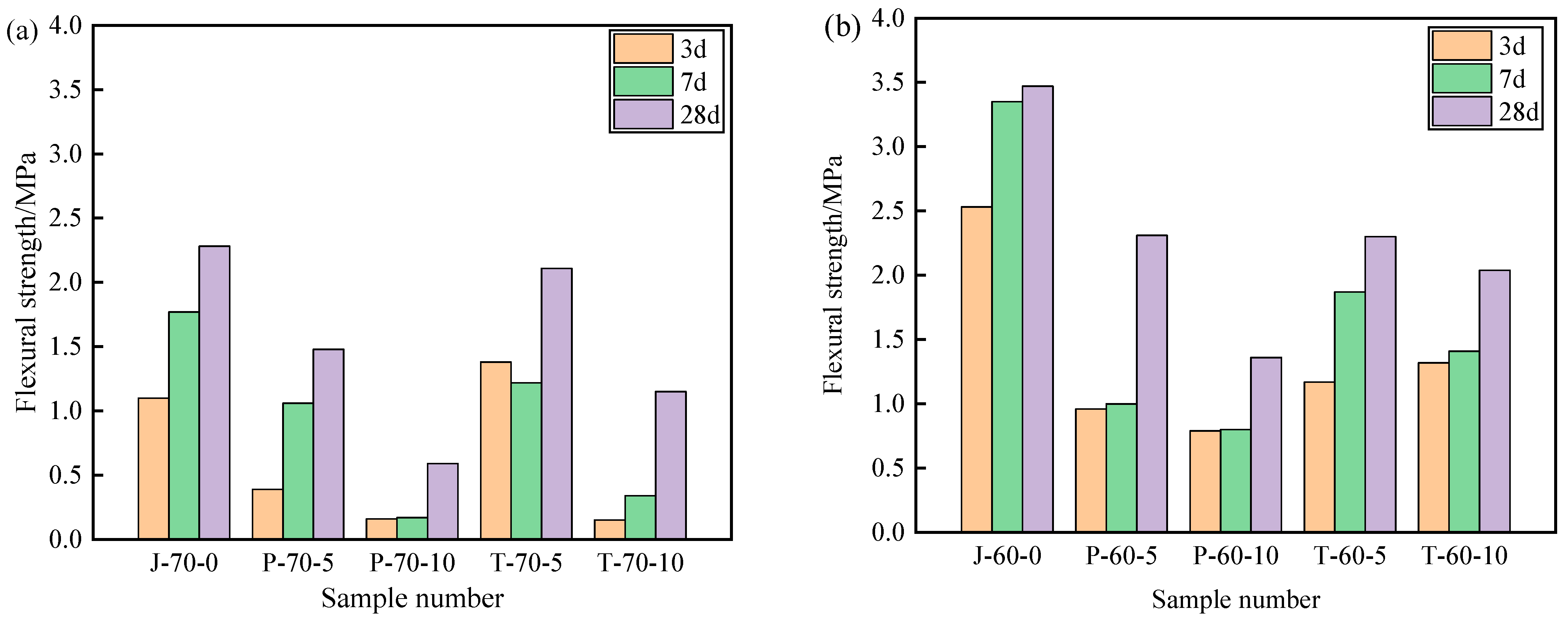
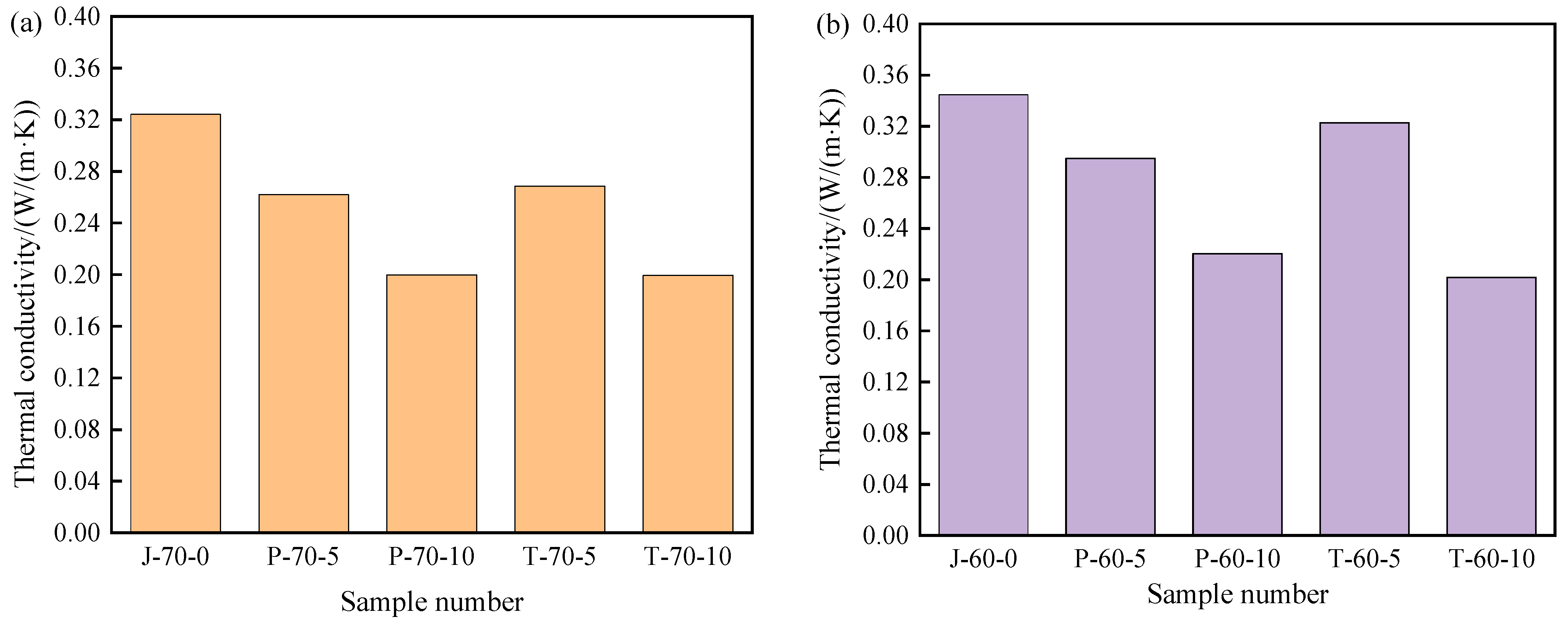
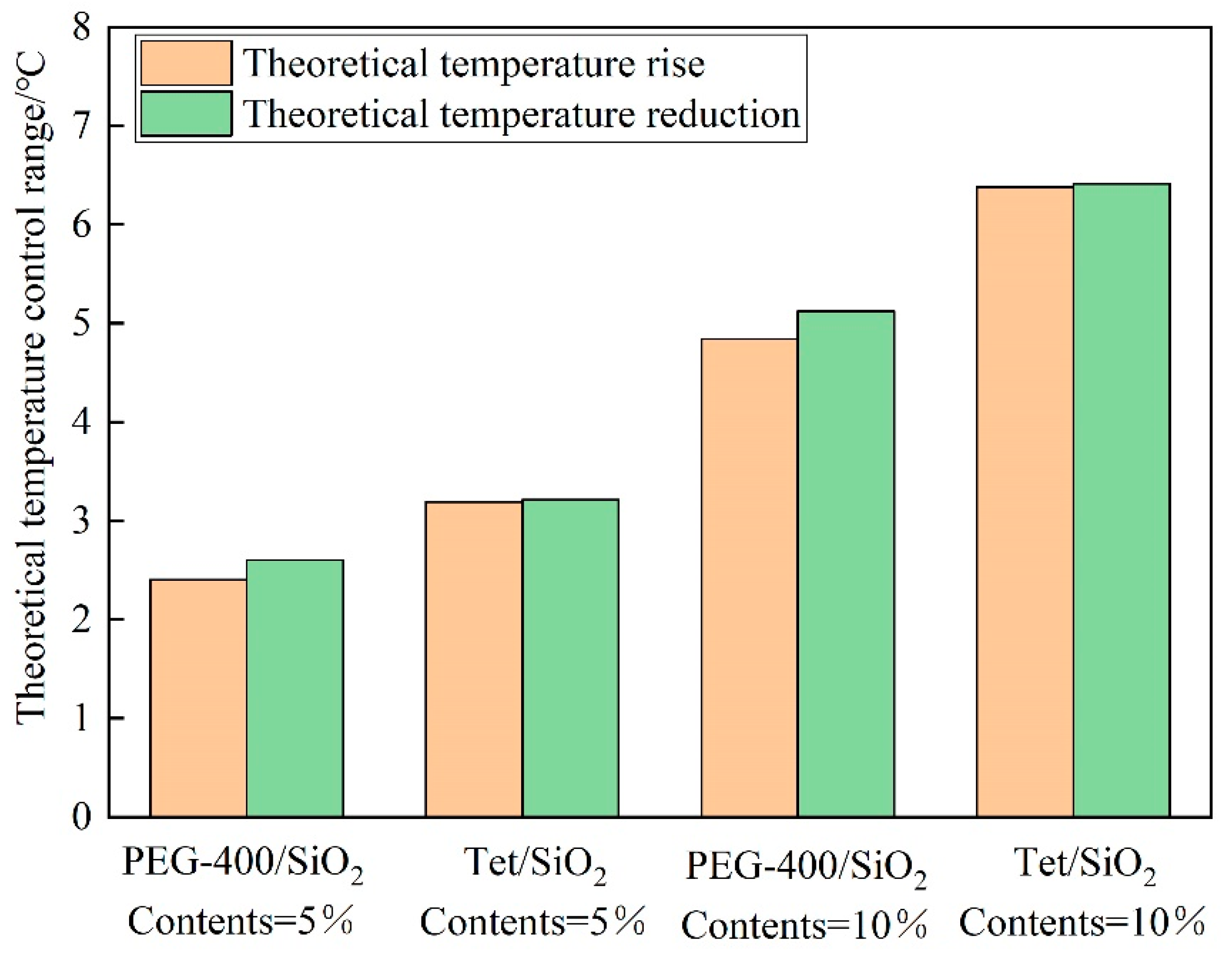
| Material Types | Parameters | Purity Grade | Characteristics | Average Molecular Weight |
|---|---|---|---|---|
| Capsule core material | PEG-400 | Analytical pure | Colorless oily liquid | 380–420 |
| Tet | Analytical pure | Colorless liquid | 198.44 | |
| Capsule wall material | Anhydrous alcohol | Analytical pure | Colorless liquid | 40.07 |
| Diisooctyl sebacate | Chemically pure | Colorless oily liquid | 426.67 | |
| Ethyl cellulose | Analytical pure | White powdery solid | 448.47 |
| Composite Shaped PCM | Ratio of PCM to SiO2 | Ratio of Composite Shaped PCM to Liquid Phase Gel System | Mass Fraction of Gel System |
|---|---|---|---|
| PEG-400/SiO2 | 5:3 | 1:0.45 | 8.5% |
| Tet/SiO2 | 1:1 | 1:0.45 | 8.5% |
| Sample Number | Recycled Aggregate | Composite Shaped PCM | Cement + Water | Water/Cement | |||
|---|---|---|---|---|---|---|---|
| Mass (g) | Ratio (%) | Mass (g) | Ratio (%) | Mass (g) | Ratio (%) | ||
| J-70-0 | 945 | 70 | 0 | 0 | 405 | 30 | 0.5 |
| J-60-0 | 810 | 60 | 0 | 0 | 540 | 40 | 0.5 |
| P-70-5 | 945 | 70 | 67.5 | 5 | 337.5 | 25 | 0.5 |
| P-70-10 | 945 | 70 | 135 | 10 | 270 | 20 | 0.5 |
| P-60-5 | 810 | 60 | 67.5 | 5 | 472.5 | 35 | 0.5 |
| P-60-10 | 810 | 60 | 135 | 10 | 405 | 30 | 0.5 |
| T-70-5 | 945 | 70 | 67.5 | 5 | 337.5 | 25 | 0.5 |
| T-70-10 | 945 | 70 | 135 | 10 | 270 | 20 | 0.5 |
| T-60-5 | 810 | 60 | 67.5 | 5 | 472.5 | 35 | 0.5 |
| T-60-10 | 810 | 60 | 135 | 10 | 405 | 30 | 0.5 |
| Strength Grading | Average Compressive Strength/MPa | Minimum Value of Single Brick/MPa |
|---|---|---|
| MU20 | 20.0 | 16.0 |
| MU15 | 15.0 | 12.0 |
| MU10 | 10.0 | 8.0 |
| MU7.5 | 7.5 | 6.0 |
| MU5 | 5.0 | 4.0 |
| MU3.5 | 3.5 | 2.8 |
Publisher’s Note: MDPI stays neutral with regard to jurisdictional claims in published maps and institutional affiliations. |
© 2022 by the authors. Licensee MDPI, Basel, Switzerland. This article is an open access article distributed under the terms and conditions of the Creative Commons Attribution (CC BY) license (https://creativecommons.org/licenses/by/4.0/).
Share and Cite
Ru, C.; Li, G.; Guo, F.; Sun, X.; Yu, D.; Chen, Z. Experimental Evaluation of the Properties of Recycled Aggregate Pavement Brick with a Composite Shaped Phase Change Material. Materials 2022, 15, 5565. https://doi.org/10.3390/ma15165565
Ru C, Li G, Guo F, Sun X, Yu D, Chen Z. Experimental Evaluation of the Properties of Recycled Aggregate Pavement Brick with a Composite Shaped Phase Change Material. Materials. 2022; 15(16):5565. https://doi.org/10.3390/ma15165565
Chicago/Turabian StyleRu, Chaojie, Guoxin Li, Fanxing Guo, Xuedi Sun, Deliang Yu, and Zheng Chen. 2022. "Experimental Evaluation of the Properties of Recycled Aggregate Pavement Brick with a Composite Shaped Phase Change Material" Materials 15, no. 16: 5565. https://doi.org/10.3390/ma15165565
APA StyleRu, C., Li, G., Guo, F., Sun, X., Yu, D., & Chen, Z. (2022). Experimental Evaluation of the Properties of Recycled Aggregate Pavement Brick with a Composite Shaped Phase Change Material. Materials, 15(16), 5565. https://doi.org/10.3390/ma15165565





